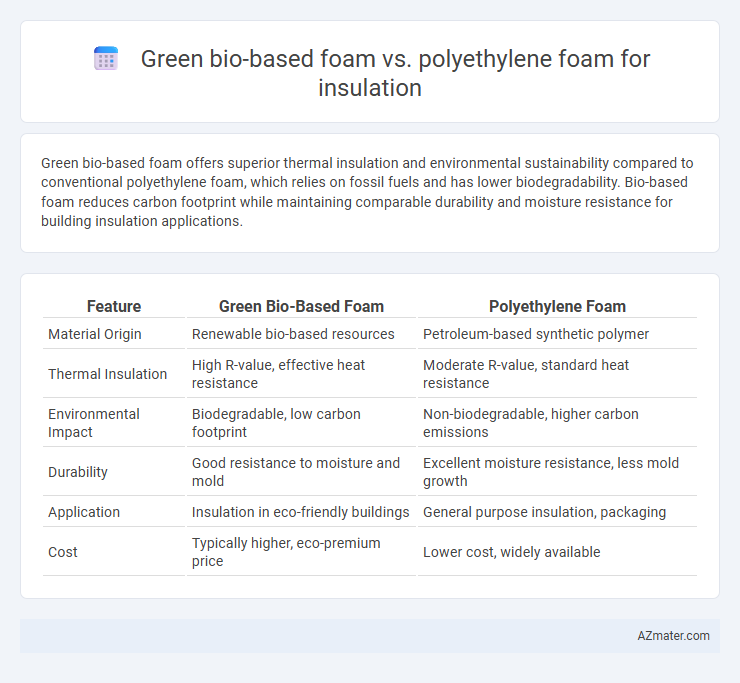Green bio-based foam offers superior thermal insulation and environmental sustainability compared to conventional polyethylene foam, which relies on fossil fuels and has lower biodegradability. Bio-based foam reduces carbon footprint while maintaining comparable durability and moisture resistance for building insulation applications.
Table of Comparison
| Feature | Green Bio-Based Foam | Polyethylene Foam |
|---|---|---|
| Material Origin | Renewable bio-based resources | Petroleum-based synthetic polymer |
| Thermal Insulation | High R-value, effective heat resistance | Moderate R-value, standard heat resistance |
| Environmental Impact | Biodegradable, low carbon footprint | Non-biodegradable, higher carbon emissions |
| Durability | Good resistance to moisture and mold | Excellent moisture resistance, less mold growth |
| Application | Insulation in eco-friendly buildings | General purpose insulation, packaging |
| Cost | Typically higher, eco-premium price | Lower cost, widely available |
Introduction: The Rise of Sustainable Insulation Solutions
Green bio-based foam insulation demonstrates superior environmental benefits compared to traditional polyethylene foam due to its renewable raw materials and lower carbon footprint. It offers comparable thermal performance while enhancing indoor air quality by reducing toxic off-gassing often associated with polyethylene foam. The growing demand for eco-friendly construction materials drives increased adoption of green bio-based foam in sustainable building projects.
Understanding Green Bio-Based Foam Insulation
Green bio-based foam insulation offers superior environmental benefits compared to traditional polyethylene foam by utilizing renewable resources like plant oils and agricultural byproducts, resulting in reduced carbon footprint and enhanced biodegradability. Its cellular structure provides excellent thermal resistance and moisture barrier properties, making it effective for energy-efficient building applications. The reliance on sustainable materials also minimizes harmful emissions during production, promoting healthier indoor air quality and compliance with green building standards.
Overview of Polyethylene Foam Insulation
Polyethylene foam insulation offers excellent thermal resistance with an R-value typically ranging from 3.5 to 4.0 per inch, making it effective for reducing heat transfer in buildings. This closed-cell foam material is lightweight, moisture-resistant, and provides good cushioning, which enhances durability against compression and environmental factors. Polyethylene foam's widespread use in construction and packaging stems from its cost-effectiveness and versatility, although it lacks the environmental benefits found in green bio-based foam alternatives.
Comparative Thermal Performance
Green bio-based foams exhibit superior thermal insulation properties due to their low thermal conductivity, often ranging between 0.030 to 0.040 W/m*K, which enhances energy efficiency in buildings. Polyethylene foam typically has higher thermal conductivity values around 0.035 to 0.045 W/m*K, resulting in moderately less effective insulation performance. The inherent cellular structure and natural composition of bio-based foam provide improved breathability and moisture resistance compared to polyethylene foam, contributing to more stable thermal performance over time.
Environmental Impact and Carbon Footprint
Green bio-based foam offers significant environmental benefits over polyethylene foam due to its renewable raw materials and biodegradability, resulting in a substantially lower carbon footprint. The production of bio-based foam typically emits fewer greenhouse gases and relies on sustainable resources like plant-based feedstocks, reducing dependence on fossil fuels. In contrast, polyethylene foam is derived from petrochemicals, contributing to higher carbon emissions and persistence in landfills, which exacerbates environmental degradation.
Durability and Lifespan Analysis
Green bio-based foam offers superior biodegradability and resistance to environmental degradation compared to traditional polyethylene foam, making it a sustainable choice for insulation with a comparable lifespan. Polyethylene foam is known for its excellent durability, chemical resistance, and moisture barrier properties, typically lasting 20-30 years in insulation applications. The lifespan of green bio-based foam varies depending on formulation but generally ranges from 10 to 25 years, with ongoing advancements aiming to enhance its durability without compromising eco-friendliness.
Moisture Resistance and Mold Prevention
Green bio-based foam offers superior moisture resistance compared to polyethylene foam, as its natural materials reduce water absorption and inhibit mold growth effectively. Polyethylene foam tends to trap moisture over time, increasing the risk of mold and mildew development in insulation applications. Utilizing bio-based foam enhances indoor air quality and longevity of insulation by preventing mold formation and maintaining optimal dryness.
Installation Process and Ease of Use
Green bio-based foam offers a simplified installation process due to its lightweight composition and superior flexibility, allowing for easier handling and cutting compared to polyethylene foam. Polyethylene foam, while effective as an insulator, often requires specialized tools and adhesives for secure placement, potentially increasing labor time and complexity. The bio-based foam's compatibility with standard installation techniques reduces the need for extensive training, making it more user-friendly for both DIY and professional applications.
Cost Analysis: Bio-Based vs Polyethylene Foam
Green bio-based foam typically incurs higher upfront costs compared to polyethylene foam due to raw material expenses and specialized manufacturing processes. However, bio-based foam offers long-term savings through improved biodegradability and potential tax incentives related to sustainability. Polyethylene foam remains cost-effective for large-scale insulation projects but may result in higher environmental compliance costs over time.
Future Trends in Insulation Materials
Green bio-based foam, derived from renewable resources like plant oils and cellulose, offers enhanced sustainability and reduced carbon footprint compared to traditional polyethylene foam used in insulation. Advances in bio-based foam technology emphasize improved thermal performance, biodegradability, and integration with smart building systems for energy efficiency. Future trends indicate a growing shift towards eco-friendly insulation materials driven by stringent environmental regulations and increasing demand for green building certifications.

Infographic: Green bio-based foam vs Polyethylene foam for Insulation
 azmater.com
azmater.com